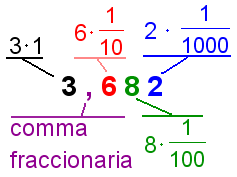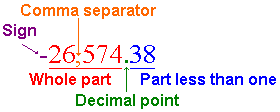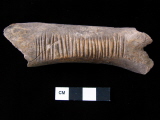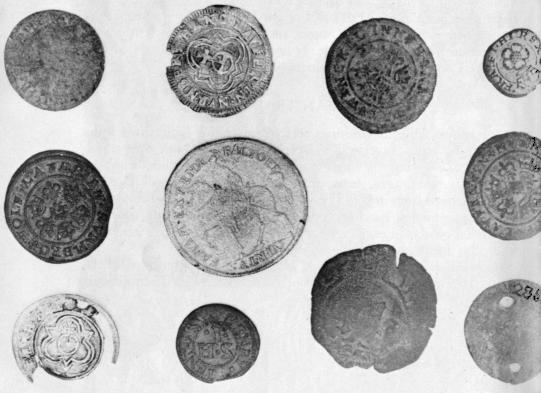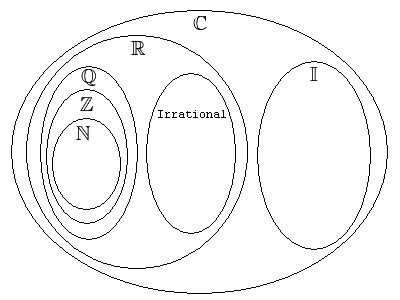Number
Pronunciation: /ˈnʌm.bər/ ExplainA number is a representation of a quantity. A quantity answers the questions, "How many?" and "How much?"
|
In figure 1 there are three apples. We can use different characters to represent
the quantity:
|
Related Words
| Numeric |
| Numerical |
| Numerically |
| Quantity |
Digits and Place Value
|
Each digit of a number has a place value. The position of the digit in the number tells the place value. For the decimal numbers, the place values are multiple of 10. Figure 2 shows a number without a decimal point. This means that the digit on the extreme right of the number has a place value of 1. The total value of the digit is 4 · 1 = 4. The digit following to the left is 7'. The place value of this digit is 1 · 10 = 10. The total value of the digit is 10 · 7 = 70. The digit to the left has a place value of 10 · 10 = 100. The total value of the digit is 3 · 100 = 300. The value of the number in figure 2 is 300 + 70 + 4. | ||
|
In figure 3, number 3.682 has a decimal point. The digit to the left of the decimal has a place value of 1. The digit to the right of the decimal has a place value of 1/10. Each digit further to the right of the decimal point has a place value of 1/10 of the previous digit. So the 6 has a total value of 6 · 1/10 = 6/10. The following digits have values of 8 · 1/100 = 8/100 and 2 · 1/1000. The value of the integral number is 3 + 6/10 + 8/100 + 2/1000. |
Parts of a Number
| A number can consist of digits, a decimal point, a positive or negative sign (+ or -), and a comma separator. |
Other Representations of Quantity
| ||||||
Brass counters and Counting boards were used to calculate numbers before calculators were invented. Figure 7 shows brass counters used at Jamestown.
| ||||||
|
Numbers have evolved as the best way to represent quantities. They can represent positive numbers, zero, and negative numbers. They can represent very large and very small numbers. They can also represent non-whole quantities such as 1.5. The only thing numbers can not represent exactly is irrational quantities. The digits in irrational values go on forever without repeating, so an irrational value can not be represented with a finite number of digits. Other representations such as π and √2 are used to represent irrational numbers exactly. |
Types of Numbers
|
Mathematicians have divided numbers into groups according to their properties. Figure 8 is a Venn diagram of number types. The group of complex numbers contains all other groups of numbers. All numbers are complex numbers. Table 2 gives the properties of the types of numbers. |
| Type | Symbol | Description | Examples |
|---|---|---|---|
| Complex Number | ℂ | A complex number is a number with a real part and an imaginary part. The real part is any real number. The imaginary part is a real number multiplied by i. i represents √-1. Since the coefficient of the imaginary part can be 0, all real numbers are also complex numbers. | 3+2i
-2.7 + 4i e3.7i |
| Real Number | ℝ | A real number is a number that can be found on the real number line. All real numbers are also complex numbers. Stated mathematically: ℝ ⊂ ℂ. | 4
3.74 e2.0 √5 π 3.5193 |
| Imaginary Number |  |
An imaginary number is a complex number with no real part. All imaginary numbers are also complex numbers. | 4i
3.74i e3πi/2 √-3 |
| Rational Number | ℚ | A rational number is a real number that can be expressed as the ratio of two integers. A number with a repeating decimal is a rational number, as all repeating decimals can be expressed as a ratio of integers. All rational numbers are also real numbers. Stated mathematically: ℚ ⊂ ℝ. | 4
Why?
3/7 √9 Why? 3.5193 Why? |
| Irrational Number | None | An irrational number is a number that can not be expressed as the ratio of two integers. The set of rational numbers combined with the set of irrational numbers makes up the set of real numbers. | π
e √5 |
| Integer | ℤ | An integer is a positive or negative whole number or zero. All integers are also rational numbers. This is because any integer a can be written a / 1. | 4
7 √9 Why? 3.0 Why? |
| Natural Number | ℕ | A natural number is the set of positive integers: {1, 2, 3, …}. These are also called counting numbers. All natural numbers are also integers. | 4
6/2 |
| Table 2: Types of numbers | |||
| Property | Description |
|---|---|
| 0 - addition by | For any real or complex number a, a + 0 = 0 + a = a. See also additive identity |
| 0 - multiplication by | For any real or complex number a, a · 0 = 0 · a = 0. |
| 0 - division by | Division by zero is undefined. |
| 1 - multiplication by | For any real or complex number a, 1 · a = a · 1 = a. |
| Absolute value | The absolute value of a number is the distance of a number from zero. If a ≥ 0, | a | = a. If a < 0, | a | = -a. |
| Addition | Addition is combining two numbers to form a sum. Addition of real and complex numbers is associative, commutative and closed. |
| Additive identity | The additive identity for real and complex numbers is 0 since, for any real or complex number a, a + 0 = 0 + a = a. |
| Additive inverse | For all real and complex numbers a, the additive inverse of a is -a. |
| Axiom of Archimedes | There is always at least one more number. For every x ∈ ℜ, there exists a number n ∈ ℜ such that n > x. |
| Division by 0 | Division by zero is undefined. |
| Equality | Equality is a property that two numbers are either equal to each other or not equal to each other. Equality of numbers is symmetric, reflexive and transitive. |
| Multiplication | Multiplication is repeated addition. a · b = a + a + a + … + a\ b times. Multiplication of real and complex numbers is associative, commutative and closed. |
| Multiplicative identity | The multiplicative identity for real and complex numbers is 1 since, for any real or complex number a, a · 1 = 1 · a = a. |
| Multiplicative inverse | For all real and complex numbers a, the multiplicative inverse of a is 1 / a. |
| Ruler Postulate | The Ruler Postulate defines the association of the real numbers with a number line. |
| Name | Description | |
|---|---|---|
| Composite number | A composite number is an integer greater than 1 that has factors other than 1 and itself. | |
| Factorial | The factorial of n is the product of all integers from 1 to n, inclusive. | |
| Fibonacci numbers | The Fibonacci numbers are a sequence of numbers starting with 0, 1. After the first two numbers, each number in the sequence is calculated by adding the two previous numbers. | |
| Googol | A googol is a very large number. 1 googol = 10100. | |
| Googolplex | A googolplex is an extremely large number. 1 googolplex = 10googol. | |
| Prime number | A prime number is an integer greater than 1 that is divisible only by 1 and itself. |
References
- McAdams, David E.. All Math Words Dictionary, number. 2nd Classroom edition 20150108-4799968. pg 127. Life is a Story Problem LLC. January 8, 2015. Buy the book
More Information
- McAdams, David E.. Complex Number. allmathwords.org. Life is a Story Problem LLC. 3/12/2009. https://www.allmathwords.org/en/c/complexnumber.html.
Cite this article as:
McAdams, David E. Number. 4/26/2019. All Math Words Encyclopedia. Life is a Story Problem LLC. https://www.allmathwords.org/en/n/number.html.Image Credits
- All images and manipulatives are by David McAdams unless otherwise stated. All images by David McAdams are Copyright © Life is a Story Problem LLC and are licensed under a Creative Commons Attribution-ShareAlike 4.0 International License.
- Apples. Unknown.
- Notched bone: Bradley J. Parker. Unknown.
- Brass counters: John L. Cotter and J. Paul Hudson. Released into the public domain.
Revision History
4/26/2019: Changed equations and expressions to new format. (McAdams, David E.)12/21/2018: Reviewed and corrected IPA pronunication. (McAdams, David E.)
9/5/2018: Removed broken links, updated license, implemented new markup. (McAdams, David E.)
8/7/2018: Changed vocabulary links to WORDLINK format. (McAdams, David E.)
8/5/2010: Added properties of numbers, special numbers. (McAdams, David E.)
12/19/2009: Added "References". (McAdams, David E.)
12/2/2008: Changed equations to images. (McAdams, David E.)
8/26/2008: In the first paragraph, organized representations of 3 into a table. (McAdams, David E.)
6/8/2008: Added types of numbers. (McAdams, David E.)
6/7/2008: Corrected spelling. (McAdams, David E.)
5/2/2008: Revised representation of irrational numbers. (McAdams, David E.)
3/22/2008: Changed Other Information to current standard. (McAdams, David E.)
11/20/2007: Initial version. (McAdams, David E.)
- Navigation
- Home
- Contents
-
# A B C D E F G H I J K L M N O P Q R S T U V W X Y Z - Teacher Aids
- Classroom Demos
- How To
- LIASP
- LIASP Home
- Conditions of Use
- Privacy Policy
- Donate to LIASP
- Help build this site
- About LIASP
- Contact LIASP
All Math Words Encyclopedia is a service of
Life is a Story Problem LLC.
Copyright © 2018 Life is a Story Problem LLC. All rights reserved.
This work is licensed under a Creative Commons Attribution-ShareAlike 4.0 International License





